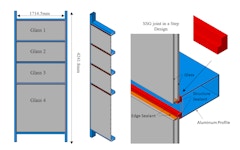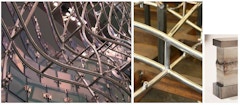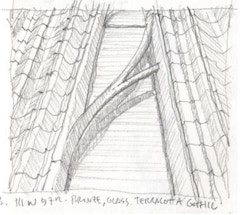18 results
-
Building façade inspections have multiple objectives, such as forensic investigation of a failure, maintenance code compliance, etc. Architects,…
-

The Carbon Footprint of Aluminum Fenestration
- Paper by Tom Bougher · Richard Braunstein
The historical focus on reducing the carbon footprint of a building has recently shifted to include more emphasis on embodied carbon, the carbon
-

End-of-Life Challenges in Facade Design
- Paper by Rebecca Hartwell · Mauro Overend
In recent decades, there has been increased attention to reduce the operational energy performance of buildings. Stringent legislation on building
-

Pioneering the Structural Terracotta Mullion Façade
- Paper by Victoria Ereskina, Façade Design Professional John Neary, Sr. Façade Specialist
Architects today must explore alternative enclosure materials to meet evolving energy codes and embodied carbon regulations. Terra cotta has been… -
Evaluating The Environmental Performance Of Stick Curtain Wall Systems
- Paper by Dima Othman, B.A.Ing., M.Eng., LEED AP Daniel Arztmann, Dipl.-Ing., M.Eng., EFN, FTI Professor for Façade Construction, Technische Hochschule Ostwestfalen Lippe (TH-OWL) Head of Building Physics,
The construction industry is one of the greatest sources of pollution, where 39% of global energy-related carbon emissions are attributed to… -
Facade Embodied Carbon Reduction Strategies
- Paper by Isabelle Hens, LEED AP BD+C, WELL AP
Facades are increasingly being recognized as a major contributor to whole-building embodied carbon. While designers know how to reduce the embodied
-

Façade Systems and Embodied Carbon
- Paper by Paulina Szpiech, Associate - Facade Engineering Valerie Leon-Green, Facade Engineer Shivanie Rambaran, Graduate Energy Analyst
Life Cycle Assessment (LCA) is a methodology used to quantify the impact of building construction supply chains on the environment in terms of… -

Two Sides to Sustainability & High-performance
- Paper by Brian Fraumeni · Julia Ragragio Ruiz, LEED AP BD+C · Adam Moqrane
High performance can be defined as “a building that integrates and optimizes all major high-performance building attributes, including energy
-
Stainless Steel 101
- Paper by Michael Mulhern
This paper presents a summary of the industry advances beyond T304 and T316 austenitic stainless steels. The greater availability of precipitation
-

Low-Carbon Cladding and Shading Design
- Paper by Prateek Jain, LEED · Isabelle Hens, LEED GA, WELL AP, EIT
In the last few years, the design community has embraced the challenge of reducing embodied carbon in buildings. Several tools are now available for
-

Evaluating Additive Manufacturing for Metallic Facade Components
- Paper by Natasa Mrazovic, M. Arch. Eng., M.C.E., Martin Fischer,
The state-of-the-art of Additive Manufacturing (AM), popularly known as 3D printing, shows its prospective future in the… -

Digital Lifecycle of Building Envelopes
“The digital transformation will change everything” – with this quote in mind a deep look into the current facade business will be given with a
-

Establishing a Life Cycle Assessment Methodology for Innovative Facade
- Paper by Vikki Lew
Life cycle assessment was introduced in the 1970s as an analytical tool to quantify the environmental impact of a product, process, or service.
-
Facade & ESG
- Paper by Vikki Lew,
In 2023, the International Sustainability Standards Board (ISSB) inaugurated the first two global sustainability disclosure standards IFRS S1/S2 to… -

Execution Ways
- Paper by Viswanath Urala, P.E., Senior Engineer Prakash R. Desai, P.E., S.E., Senior Structural Engineer
Business Insider has described San Francisco’s Chase Arena as setting “a new standard for a sports arena in the US”, and “the state-of-the-art arena… -
Carbon-Neutral High-Rise Envelope Nexus
- Paper by Thomas Spiegelhalter, Principal
The pathway to carbon-neutrality, as urged during the COP 21 in Paris, and the repeated goal for resilient buildings and urban habitats, winds right… -
Shaping Skin
- Paper by John Neary AIA LEED AP NCARB
The conventional modern facade is essentially flat, which creates the tendency toward visual monotony and problems for modulating daylight—both on
-

SSG and Seismic
- Paper by Jon Kimberlain · Valerie Hayez · Jie Feng · Mark Mirgon
With the advent of more sophisticated analysis methods and the desire to optimize geometries of structural silicone joints in high performance

